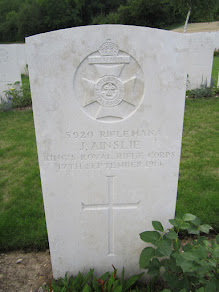James Ainslie: the First of the Kelsall Men of the First World War
James
Ainslie tops the list of names on the Kelsall War memorial, and he was also the
first fatality among the Kelsall men who went to serve in the Great War.
James
was not a scion of a Kelsall family, his father (also James) hailed from
Harborne, Smethwick in Staffordshire who was working in Chester when he met
Sarah Lloyd from Mouldsworth, then in service in the household of Henry Jones,
a banker’s clerk, of 11 Grosvenor Park Road, Hoole. James and
Sarah married on 26th June 1882 at All Saints Church,
Plemstall. They set up home at 46
Philips Street, Hoole where James was born.
He was baptized on 4th March 1883 at All Saints Church,
Hoole.
The
family moved back to Harborne. After he left school James was apprenticed to
James Bryden, a tailor in Kings Norton.
After 7 ½ years James grew restless and for either adventure or better
prospects he joined the Army on 21st January 1904, signing on in
Gosport, Hampshire into the Kings Royal Rifle Corps. After basic training in November 1904, he was
posted to the 1st battalion in Malta. The battalion later served in Egypt, which
included Sudan with some time in Khartoum, and Cyprus. In February 1909 the
battalion returned to England and was stationed at Gosport. Here James met a local girl Amelia Madge
Notley, whom he married on 4th March 1911 at the Baptist Church,
Alverstoke. James had permission to live
out of barracks, so he and Amelia set up home at 8 Percy Road, Gosport. Here their first daughter was born on 29th
June 1911.
On
31st May 1912 James’s service with the colours ended, but he
remained in the Army Reserve. The family
then moved to Kelsall to live in Chapel Square.
He found a job with Mr. Parkin, who had a tailoring shop in Tarvin High
Street. On 4th January 1914 their
second daughter Beatrice was born.
The
4th of August 1914 was a momentous day for the Ainslie
family. When the general mobilisation of
the Army was declared, as a reservist James was ordered to Aldershot to re-join
his old regiment. At dawn on the 12th of August the
regiment entrained from Farnborough for Southampton and immediately boarded
S.S. Honoris and sailed for Le Havre but missing the tide then had to wait
before they could sail up the Seine to Rouen. They then continued by train via
Arras to Vaux-Andigny. From there they
marched to Hannappes, reaching there at 5pm on the 15th. The next
five days were spent settling in and, to keep the men occupied, 6 mile route
marches were organised each day. The regiment then spent the next 2 days
marching the 29 miles towards Mons.
As
part of 6 Brigade of the 2nd Division the regiment took part in the
battles of Mons and the subsequent defeats, including the Affair of Landrecies, the Rearguard affair of Le Grand
Fayt, the Rearguard Actions of Villers-Cotterets, the Battle of the
Marne and the Battle of the Aisne
including participation in the Actions on the Aisne Height. In these
actions the attacking British forces were under bombardment from the German
artillery. In action on 16th of
September James was hit in the shoulder by shrapnel and taken to a field
hospital. Unfortunately, he died the
following day from these wounds.
James
was reburied at Vendresse British Cemetery when it was established to bring
together burials which were gathered from nearby
cemeteries and from the battlefield. For his service James qualified for
the 1914 Star with clasp, the Victory Medal and the British War Medal.
In October 1914, after Amelia heard about the death of her
husband James, she left Kelsall with her daughters and returned to Gosport to
live with her mother, her father having enlisted into the Army. In 1915 Amelia was granted a pension of 18
shillings and sixpence a week, about £60 in today’s money, for herself and two
daughters. Amelia Ainslie never remarried and died in 1956.
James Ainslie (1883-1914) RIP.
Dunvegan39







Comments
Post a Comment